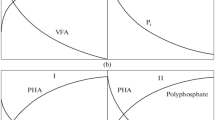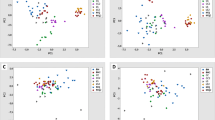Abstract
Several strains resembling members of theAcinetobacter-Moraxella-Mima group of bacteria were isolated from activated sludge-type sewage treatment plants designed for phosphate removal. The bacteria are obligate aerobes but utilize as carbon and energy sources low-molecular intermediates generated anaerobically, particularly acetate and ethanol. These bacteria can be shown to be responsible for the phosphate luxury uptake occurring in these treatment plants. The bacteria are physiologically unusual in that they perform luxury uptake of phosphates in a complete growth medium. Phosphate release occurs on addition of a carbon source to the carbon-starved bacteria, lowering pH or both. The bacteria persist in the system by virtue of their ability to form floc.
Similar content being viewed by others
References
Baumann, P., M. Doudoroff, and R. Y. Stanier, 1968. A study of theMoraxella group. II. Oxidase-negative species (genusAcinetobacter).J. Bacteriol. 95: 1520–1541.
Conn, H. J., M. W. Jennison, and O. B. Week. 1957. Routine tests for the identification of bacteria.In: “Manual of Microbiological Methods” [H. J. Conn, editor], pp. 140–168, McGraw-Hill, New York.
Frank, E. 1962. Vergleichende Untersuchungen zum Calcium-, Kalium- und Phosphathaushalt von Grünalgen. II. Calciummangel beiHydrodictyon, Sphaeroplea undChlorella.Flora 152: 157–167.
Fuhs, G. W. 1969. Interference-microscopic observations on polyphosphate granules and gas vacuoles in cyanophyceae [in German with English summary].Österr. Bot. Z. 116 (Geitler-Festschrift): 411–422.
Gordon, J., and J. W. McLeod. 1928. The practical application of the direct oxidase reaction in bacteriology.J. Pathol. Bacteriol. 31: 185–190.
Halvorson, J. F. 1963. Gliding motility in the organismsBacterium anitratum (B5W),Moraxella lwoffi ana Alkaligenes haemolysans, as compared toMoraxella nonliquefaciens.Acta Path. Microbiol. Scand. 59: 200–204.
Harold, F. M. 1966. Inorganic polyphosphates in biology: structure, metabolism, and function.Bact. Rev. 30: 772–784.
Henriksen, S.D. 1963.Mimeae. The standing in nomenclature of the names of this tribus and of its genera and species.Intern. Bull. Bacteriol. Nomen. Taxon. 13: 51–57.
Levin, G. V., inventor. U. S. Patent No. 236, 766 “Sewage Treatment Process,” issued February 22, 1966.
Levin, G. V., and J. Shapiro. 1965. Metabolic uptake of phosphorus by wastewater organisms.J. Water Pollut. Control Fed. 37: 800–821.
Lewis, K. F., H. J. Blumenthal, R. W. Weinrach, and S. Weinhouse. 1955. An isotope tracer study of glucose catabolism inPseudomonas fluorescens.J. Biol. Chem. 216: 273–286.
Lodder, J., and N. J. W. Kreger-van Rij. 1952. “The Yeasts.” North Holland, Amsterdam.
Menar, A. B., and D. Jenkins. 1970. Fate of phosphorus in wastewater treatment processes: enhanced removal of phosphate by activated sludge.Environ. Sci. Technol. 4: 1115–1121.
Meyer, A. 1904. Orientierende Untersuchungen über die verbreitung, morphologie und chemie des volutins.Bot. Ztg. 62: 113–152.
Milbury, W. F., D. McCauley, and C. H. Hawthorne. 1971. Operation of conventional activated sludge for maximum phosphorus removal.J. Water Pollut. Control Fed. 43: 1890–1901.
Moore, H. G., R. B. Higgins, and E. G. Fruh, 1969. Surplus phosphorus uptake by microorganisms. Batch tests with diluted activated sludge cultures. Center for Research in Water Resources Report No. 41, Environmental Health Engineering Program, The University of Texas, Austin.
Murphy, J., and J. P. Riley. 1962. A modified single solution method for the determination of phosphate in natural waters.Anal. Chim. Acta 27: 31–36.
Rowan, K. W. 1966. Phosphorus metabolism in plants.Intern Rev. Cytol. 19: 201–290.
Shapiro, J. 1967. Induced release and uptake of phosphate by microorganisms.Science 155: 1269–1271.
Shapiro, J., G. V. Levin, and H. G. Zea. 1967. Anoxically induced release of phosphate in wastewater treatment.J. Water Pollut. Control Fed. 39: 1810–1818.
Skerman, V. B. D. 1959. “A Guide to the Identification of the Genera of Bacteria.” The Williams and Wilkins Co., Baltimore.
Thomas, E. A. 1965. Phosphat-Elimination in der Belebtschlammanlage von Männedorf und Phosphate-Fixation in See und Klärschlamm.Vierteljahresschr. Naturf. Ges. Zürich 110: 419–434.
Vacker, D., C. H. Connell, and W. N. Wells. 1967. Phosphate removal through municipal wastewater treatment at San Antonio, Texas.J. Water Pollut. Control Fed. 39: 750–771.
Voelz, H., V. Voelz, and R. O. Ortigoza. 1966. The “polyphosphate overplus” phenomenon inMyxococcus xanthus and its influence on the architecture of the cell.Arch. Mikrobiol. 53: 371–388.
Weinberger, L. W. 1949. Nitrogen metabolism in the activated sludge process. Ph.D. thesis, Massachusetts Institute of Technology.
White, G. A., and C. H. Wang. 1964. The dissimilation of glucose and gluconate byAcetobacter xylinum, I, II.Biochem. J. 90: 408–430.
Wood, L. W., and K. E. Chua. 1973. Glucose flux at the sediment-water interface of Toronto Harbour, Lake Ontario, with reference to pollution stress.Canad. J. Microbiol. 19: 413–420.
Yall, I., W. H. Boughton, R. C. Knudsen, and N. A. Sinclair. 1970. Biological uptake of phosphorus by activated sludge.Appl. Microbiol. 20: 145–150.
Rights and permissions
About this article
Cite this article
Fuhs, G.W., Chen, M. Microbiological basis of phosphate removal in the activated sludge process for the treatment of wastewater. Microb Ecol 2, 119–138 (1975). https://doi.org/10.1007/BF02010434
Issue Date:
DOI: https://doi.org/10.1007/BF02010434




